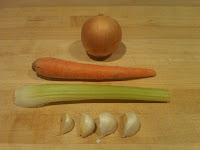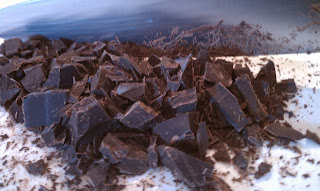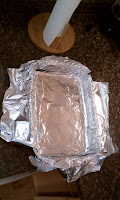
I know everyone says that spanakopita is an obvious answer to the "what to serve vegetarians" question. Or in my particular case the "what to feed vegetarians who don't for some crazy unknown reason love mushrooms"? But this spanakopita has a ton of flavor, some unconventional pine nuts, and the pepper on top that really make this recipe. Plus, this recipe was my introduction to phyllo, which gave me confidence to try other things phyllo and thus unlock a whole new world of cooking. Adding the bread crumbs really does help prevent the sheets from sticking together as you assemble them.
This recipe can be a little time intensive. Layering out all that phyllo and rolling the triangles takes time. The benefit of it, however, is that as long as you're doing phyllo, you can do a lot, and it freezes quite well. I almost always make at least a double recipe and save the leftovers. When it's a weekday and TK and I have both worked late but frankly don't want the grease of delivery, there's delicious homemade spanakopita. You don't even have to thaw them, in fact, you don't want to thaw them at all, as that would make the phyllo soggy when cooked. Pop them straight from the freezer to a cookie sheet, top with melted butter, salt, and pepper, and cook.
Two triangles make a meal. One makes a solid side or first course. If you want appetizer-sized triangles, Cut horizontally six ways instead of vertically halfways and use a tablespoon instead of a 1/4 cup measure. The smaller triangles will be more delicate but can likewise be frozen. There will be plenty of filling for all the phyllo you desire. One box per batch. Try your feta before you add it. You may have to adjust the salt content of the dish based on how salty your feta is. We like to serve with a quick dipping sauce of yogurt, cucumber, lemon juice and pepper.
Ingredients
1/4 cup good olive oil
1 cup chopped yellow onion
3 scallions, white and green parts, chopped
2 (10-ounce) packages frozen chopped spinach, defrosted
4 extra-large eggs, lightly beaten
3 tablespoons freshly grated Parmesan cheese
Plain dry bread crumbs (not seasoned or panko)
1 teaspoon grated nutmeg
2 teaspoons kosher salt
1 teaspoon freshly ground black pepper
2 cups small-diced feta cheese (12 ounces)
3 tablespoons toasted pine nuts
24 sheets frozen phyllo dough, defrosted
1/4 pound (1 stick) unsalted butter, melted
Flaked sea salt, such as Maldon, for sprinkling
Directions
- Thaw frozen spinach in strainer until no ice remains.
- Preheat the oven to 375 degrees F.
- Heat the olive oil in a medium saute pan, add the onion, and cook for 5 minutes over medium-low heat. Add the scallions, and cook for another 2 minutes until the scallions are wilted but still green.
- Meanwhile, gently squeeze the water out of the spinach and place in a large bowl.
- When the onion and scallions are done, add them to the spinach. Mix in the eggs, Parmesan cheese, 3 tablespoons bread crumbs, the nutmeg (use a rasp to grate if you have fresh nutmeg), salt, and pepper. Gently fold in the feta and pine nuts.
- Place 1 sheet of phyllo dough flat on a work surface with the long end in front of you. Brush the dough lightly with butter and sprinkle it with a teaspoon of bread crumbs.
- Working quickly, slide another sheet of phyllo dough on top of the first, brush it with butter, and sprinkle lightly with bread crumbs. (Use just enough bread crumbs so the layers of phyllo don't stick together.) Pile 4 layers total on top of each other this way, brushing each with butter and sprinkling with bread crumbs.
- Cut the sheets of phyllo in half lengthwise.
- Place 1/3 cup spinach filling in the bottom right corner of the strips of phyllo. If necessary, shape the filling to make sure it fills the corners of the triangle you are about to form. Fold the phyllo over the filling diagonally like you are folding a flag (see video). Then fold the triangle of phyllo over straight and then diagonally again. Continue folding first diagonally and then straight until you reach the end of the sheet and the filling is enclosed in the phyllo.
- Continue assembling phyllo layers and folding the filling until all of the filling is used or you run out of phyllo. If you are planning on serving later, freeze the folded phyllo triangles in a tupperware containern neatly stacked until you are ready to cook, then continue on with the directions, placing the frozen unthawed triangles on the sheet pan.
- Place on a sheet pan, seam sides down. Brush with melted butter, sprinkle with flaked salt, and bake for 30 to 35 minutes, until the phyllo is browned and crisp. Serve hot.


















































